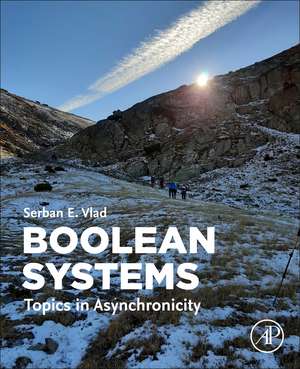Boolean Systems: Topics in Asynchronicity
Autor Serban E. Vladen Limba Engleză Paperback – 11 ian 2023
- Presents a consistent and original theory of the discrete-time Boolean asynchronous systems, which are useful for mathematicians and computer scientists interested in Boolean Networks, dynamical systems, and modeling.
- Studies the flows and equations of evolution, nullclines, dependence on initial conditions, periodicity, path-connectedness, topological transitivity, chaos, nonwandering points, invariance, connectedness, and separation, as well as the basins of attraction, attractors, stability, and time-reversal symmetry.
- Explains the fundamental operating mode of the input systems and the combinational systems (systems without feedback).
- Includes a chapter of applications of the Boolean systems and their modeling techniques.
- Makes use of the unbounded delay model of computation of the Boolean functions.
Preț: 807.52 lei
Preț vechi: 1054.64 lei
-23% Nou
Puncte Express: 1211
Preț estimativ în valută:
154.52€ • 161.74$ • 128.61£
154.52€ • 161.74$ • 128.61£
Carte tipărită la comandă
Livrare economică 24 martie-07 aprilie
Preluare comenzi: 021 569.72.76
Specificații
ISBN-13: 9780323954228
ISBN-10: 0323954227
Pagini: 456
Dimensiuni: 191 x 235 x 25 mm
Greutate: 0.78 kg
Editura: ELSEVIER SCIENCE
ISBN-10: 0323954227
Pagini: 456
Dimensiuni: 191 x 235 x 25 mm
Greutate: 0.78 kg
Editura: ELSEVIER SCIENCE
Public țintă
Mathematicians and Computer Scientists interested in Boolean Systems, dynamical systems, and Boolean networks, and their use in computational modelling, as well as researchers, engineers, and industry professionals in biological science, discrete systems, systems science, and control science.Cuprins
1. Boolean Functions
2. Morphisms of Generator Functions
3. State Portraits
4. Signals
5. Computation Functions and Progressiveness
6. Flows and Equations of Evolution
7. Systems
8. Morphisms of Flows
9. Nullclines
10. Fixed points
11. Sources, Isolated Fixed Points, Transient Points, Sinks
12. Sets of Reachable States
13. Dependence on the Initial Conditions
14. Periodicity
15. Path Connectedness and Topological Transitivity
16. Chaos
17. Nonwandering Points and Poisson Stability
18. Invariance
19. Relatively Isolated Sets, Isolated Set
20. Maximal Invariant Subset
21. Minimal Invariant Superset
22. Minimal Invariant Subset
23. Connectedness and Separation
24. Basins of Attraction
25. The Basins of Attraction of the States
26. Local Basins of Attraction
27. Local Basins of Attraction of the States
28. Attractors
29. Stability
30. Time Reversal Symmetry
31. Generator functions with one parameter
32. Input Flows and Equations of Evolution
33. Input systems
34. The Fundamental (Operating) Mode
35. Combinational Systems with One Level
36. Combinational systems
37. Wires, Gates, and Flip Flops
Appendix
A. Continuous Time
B. Theory of Cheng
C. Notations
2. Morphisms of Generator Functions
3. State Portraits
4. Signals
5. Computation Functions and Progressiveness
6. Flows and Equations of Evolution
7. Systems
8. Morphisms of Flows
9. Nullclines
10. Fixed points
11. Sources, Isolated Fixed Points, Transient Points, Sinks
12. Sets of Reachable States
13. Dependence on the Initial Conditions
14. Periodicity
15. Path Connectedness and Topological Transitivity
16. Chaos
17. Nonwandering Points and Poisson Stability
18. Invariance
19. Relatively Isolated Sets, Isolated Set
20. Maximal Invariant Subset
21. Minimal Invariant Superset
22. Minimal Invariant Subset
23. Connectedness and Separation
24. Basins of Attraction
25. The Basins of Attraction of the States
26. Local Basins of Attraction
27. Local Basins of Attraction of the States
28. Attractors
29. Stability
30. Time Reversal Symmetry
31. Generator functions with one parameter
32. Input Flows and Equations of Evolution
33. Input systems
34. The Fundamental (Operating) Mode
35. Combinational Systems with One Level
36. Combinational systems
37. Wires, Gates, and Flip Flops
Appendix
A. Continuous Time
B. Theory of Cheng
C. Notations
Recenzii
"The book under consideration consists of 37 Chapters and 3 Appendices. In it mathematical theory of the Boolean asynchronous systems is presented. The first chapters are introductory about the system and its dependence on the initial conditions, periodicity, path-connectedness, topological transitivity and chaos. For the Boolean systems one very important property is the invariance. For this reason the author presents the study of the maximal invariant subset, the minimal invariant superset, the minimal invariant subset, connectedness, separation, basin of attractions and attractors. The stability of the autonomous systems is studied together with their time-reversal symmetry. Then the systems with input are presented with the generator functions.... The book is rich of examples, which makes it interesting not only for mathematicians but also for computer scientists." --Angela Slavova, zbMATHOpen
